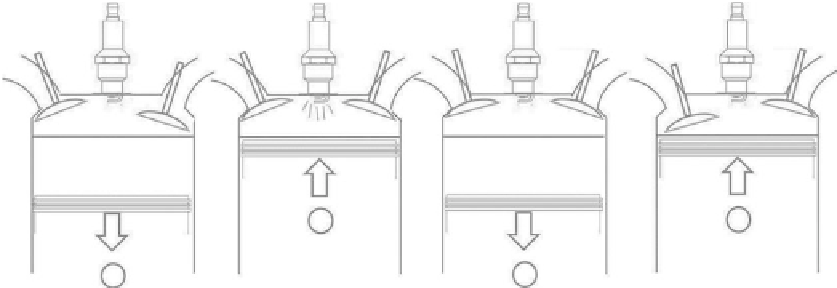Environmental Engineering Reference
In-Depth Information
by a factor of 10 in PM (from 0.1 to 0.01 g/bhp-h) and NO
x
(from 2 to 0.2 g/bhp-h), respectively
(U.S. EPA 2010g). In the case of diesel CI engine combustion, there is an inherent NO
x
-soot tradeoff
that is based on the temperature-equivalence ratio path that combustion follows, making emission
control difficult. To meet the 2007-2010 standards, diesel engines now incorporate complex after-
treatment systems that typically include an oxidation catalyst, a continuously regenerating PM trap,
and a lean NO
x
reduction system such as a selective-catalyst-reduction/urea system.
Evaporative emissions are those that can come from fuel in storage tanks during various drive
and park cycles and as a result of refueling the vehicle. These, in addition to the tailpipe emis-
sions outlined above, have been regulated for gasoline-fueled vehicles because of the fuel's high
volatility. Evaporative emissions are composed of light volatile organic compounds (VOCs) in the
fuel and cause ground-level ozone problems and human health issues (U.S. EPA 2007b; de Nevers
2000). Tier 2 evaporative emission standards for LDVs include a three-diurnal test combined with
a hot soak (after engine operates above ambient temperatures and is shut down) along with running
losses, being 0.50 g/test and 0.05 g/mi for LDVs in model year 2009 (U.S. EPA 2009).
To maintain these standards, vehicles must include on-board-diagnostic (OBD) systems to con-
tinuously monitor all components that would result in the failure of the vehicle to meet these stan-
dards. If a failure occurs, a diagnostic check engine light informs the driver of a problem and
diagnostic codes on the faulty component(s) are stored and used for servicing purposes.
10.2
Ic enGInes
10.2.1 B
aSic
E
nginE
o
pEration
The IC engine has existed since the 19th century, when pioneers including Jean Lenoir, Nicholas
Otto, and Rudolf Diesel proved that the concept of a heat engine relying upon IC was a viable mech-
anism (Cummins 1989). An IC engine is a mechanical device that converts energy contained within
chemical bonds in the fuel into kinetic energy in the form of a rotating shaft that can be used to do
useful work. The four-stroke cycle engine, which is used in nearly all transportation vehicles, con-
sists of a piston moving up and down within a cylinder inside of the engine. The piston is connected
to a crankshaft; thus, the reciprocating motion of the piston is translated via the connecting rod and
crankshaft into rotational kinetic energy at the shaft. The engine operates on a cycle, wherein the
piston makes four distinct strokes of the cylinder over two revolutions of the crankshaft as shown in
Figure 10.6. These four strokes are described as follows:
Exhaust
Intake
Exhaust
Intake
Exhaust
Intake
Exhaust
Intake
Intake stroke
Piston moves down,
induct charge;
Cl - air + residuals
Sl - air + fuel
Compression stroke
Piston moves up,
compress gases;
Sl - spark plug fires
Cl - fuel injection
Expansion stroke
Piston moves down by
force of combustion gases.
Useful work output.
Exhaust stroke
Piston moves up, exhaust
gases pushed out of cylinder
FIGure 10.6
Four-stroke engine operating cycle. SI engine shown with spark-plug for ignition.



